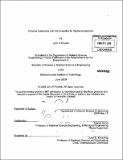Polymer substrates with microneedles for epidermis injection
Author(s)
Pavlish, John R
DownloadFull printable version (7.910Mb)
Other Contributors
Massachusetts Institute of Technology. Dept. of Materials Science and Engineering.
Advisor
Darrell Irvine.
Terms of use
Metadata
Show full item recordAbstract
Injections of medicine into the body are commonplace, whether they be intravenous or capsules. The benefit of using a macroneedle for injecting cargo into the circulatory system is its simplicity. However, introduction of the needle intravenously can also include foreign matter if the needle is unsterile. Due to macroneedles ability to pierce skin and veins for effortless insertion, it can also damage unintentional areas if a patient resists the needle, or if it is poorly inserted. Thus the body can be subjected to undesirable materials beyond the intension medicine cargo. Current research reevaluates methods of introducing cargo medicine into the body. Popular models consider polymer substrates with different surface designs and medicine release. Thin polymer substrates allow flexible construction for adhering to tissue while specfic polymers with high Young's modulus create strength for rigidity. Cargo can be placed within or on top of the substrate itself for release to the epidermis or dermis in stages, which is difficult for both oral medicine and macroneedles. A spectic substrate system with microneedles can prevent irflammation or tear of the epidermis but still puncture for cargo release. Depending on the substrate contact surface area, a larger microneedle array can be utilized, for a higher success rate of release beyond individual microneedles. Microneedles can carry and release medicine either internally or externally through the epidermis. In the latter, Langerhans cells can be utilized for activating the immune system by releasing antigenes. Aims of this thesis show the effects of polymer microneedle substrates with methods for constructing the substrate arrays that are flexible adherent to the epidermis, rigid enough for puncturing the stratum corneum, but not weak enough to buckle or be brittle.
Description
Thesis (S.B.)--Massachusetts Institute of Technology, Dept. of Materials Science and Engineering, 2009. Cataloged from PDF version of thesis. Includes bibliographical references (p. 31).
Date issued
2009Department
Massachusetts Institute of Technology. Department of Materials Science and EngineeringPublisher
Massachusetts Institute of Technology
Keywords
Materials Science and Engineering.